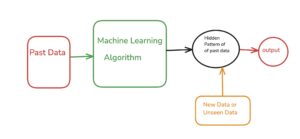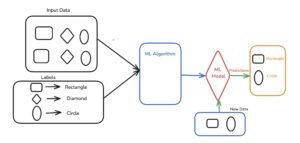Machine learning (ML) is a subset of artificial intelligence that focuses on the development of algorithms that allows computers to learn from and make predictions or decision based on data
An algorithm is a step-by-step procedure for solving a problem, while machine learning uses data-driven algorithms to learn patterns and make decisions without explicit programming.
Note- Instead of explicitly adding programming rules, ML algorithms identify patterns in data by learning from past data or history data.
EXAMPLE : An algorithm follows a fixed formula, like calculating house price using:
Price = (Area × Rate per sq. ft) + Fixed Cost
Machine learning, however, learns from past house sales data to find complex patterns and predict prices more accurately without a fixed formula.
Machine learning algorithms are derived from mathematical functions , it takes input and predicts output.
 \
\
Types of Machine Learning – Machine learning are basically three types , Supervised , unsupervised and reinforcement learning
Supervised learning
The model is trained on labeled data set , like predicting shapes(Rectangle,Circle,Diamond etc..) based on their labels

Unsupervised Learning
The model trained on unlabelled data set ,predicting the boxes based on their shapes or hidden patterns like diamond,rectangle,circles etc

Reinforcement learning
Reinforcement learning is a way for computers to learn by trying different actions, getting rewards for good choices, and improving over time, like a self-driving car: it continuously learns by making decisions like turning, braking, or speeding up, receiving rewards for safe driving and penalties for mistakes, improving its driving over time..
Types of Machine learning Problems
There are basically four types of machine learning problems , Regression Problem ,classification problem ,clustering , Decision Tress and Ensembling
Regression is a supervised machine learning problem that predicts continuous values. For example, it can be used to predict house prices based on factors like size, location, and amenities, or to forecast stock prices based on historical data and market trends.
Classification is a supervised machine learning problem that predicts discrete categories. For example, it can be used to classify emails as spam or not spam, or to identify whether an image contains a cat or a dog.
Decision Trees are a supervised machine learning method that splits data into branches based on decision rules to make predictions. For example, it can be used to decide whether a customer will buy a product based on factors like age, income, and previous purchases.
Ensembling is a supervised machine learning technique. It combines multiple individual models (like decision trees, for example) to make predictions, aiming to improve accuracy and reduce overfitting. Common ensemble methods include Random Forest and Gradient Boosting.
Clustering is an unsupervised machine learning problem that groups similar data points together. For example, it can be used to group customers based on purchasing behavior or to segment images based on color patterns.